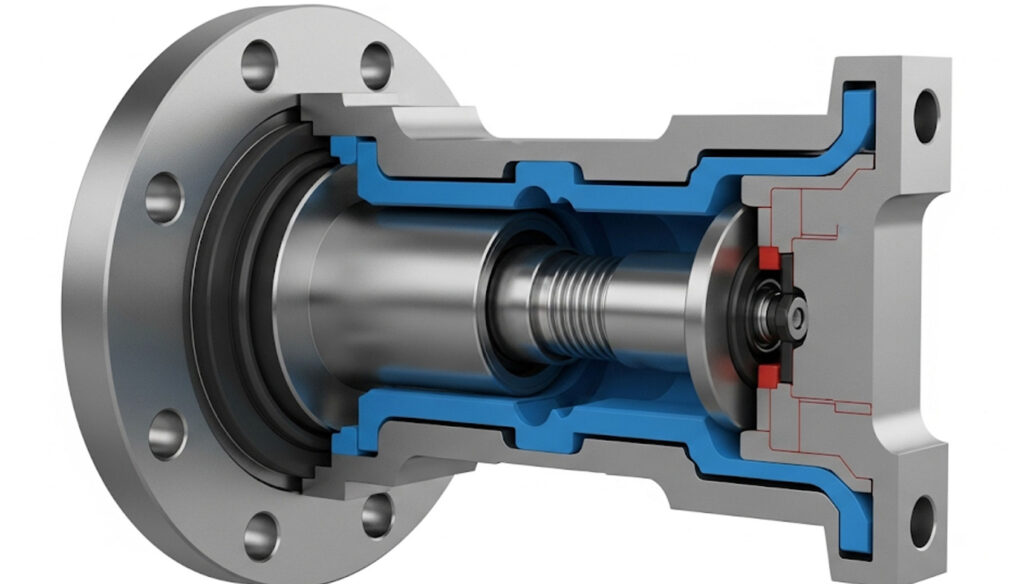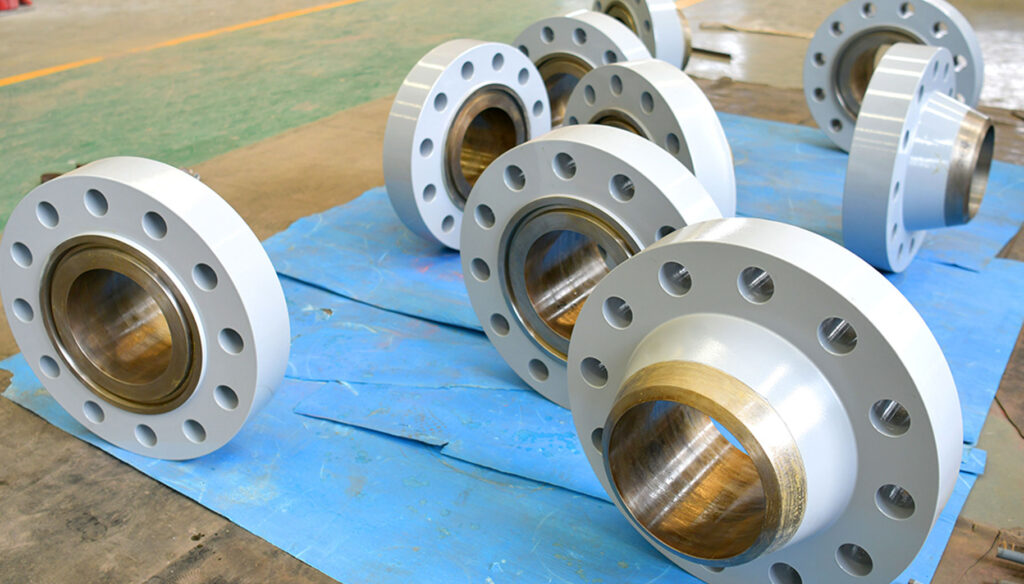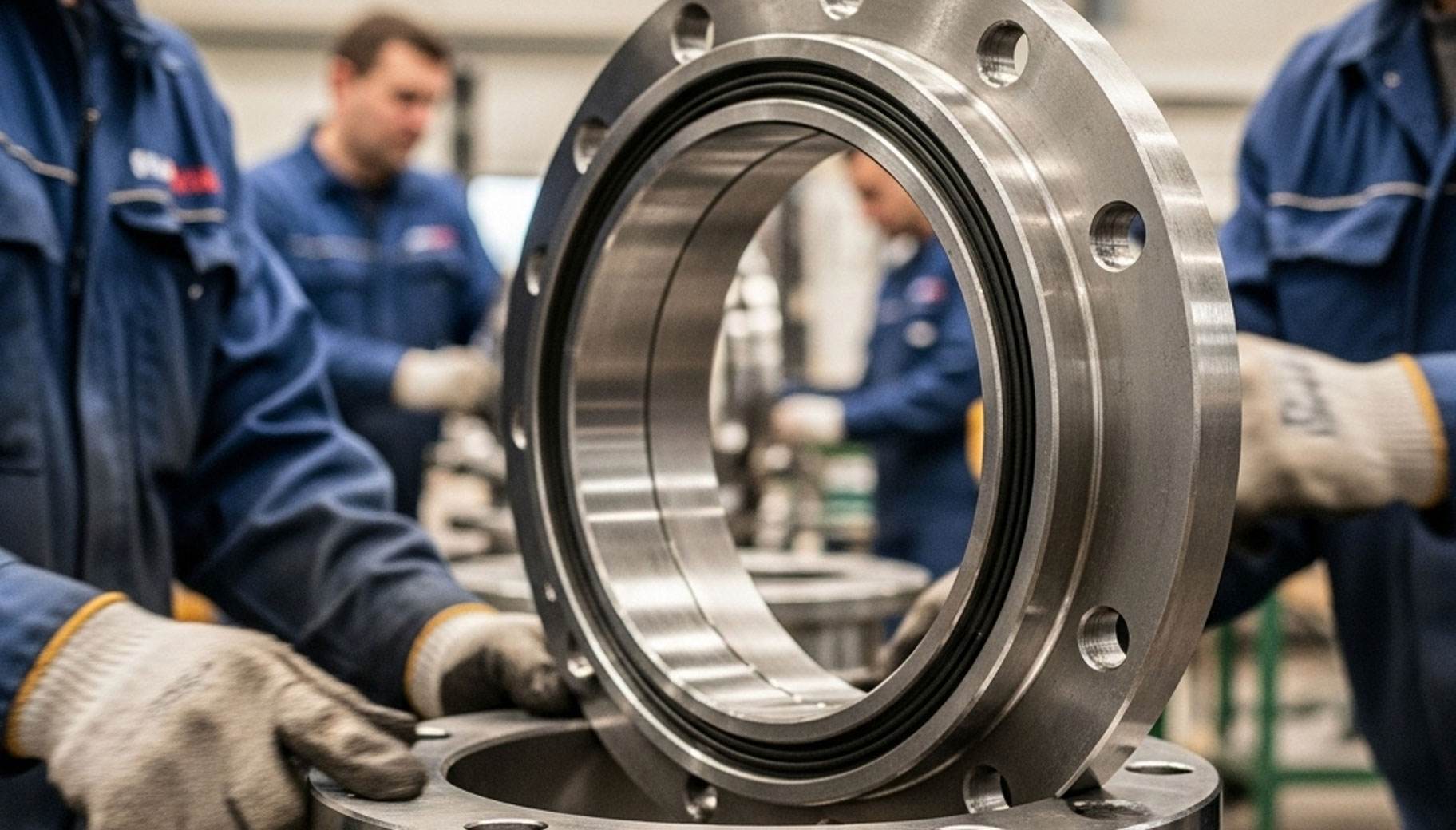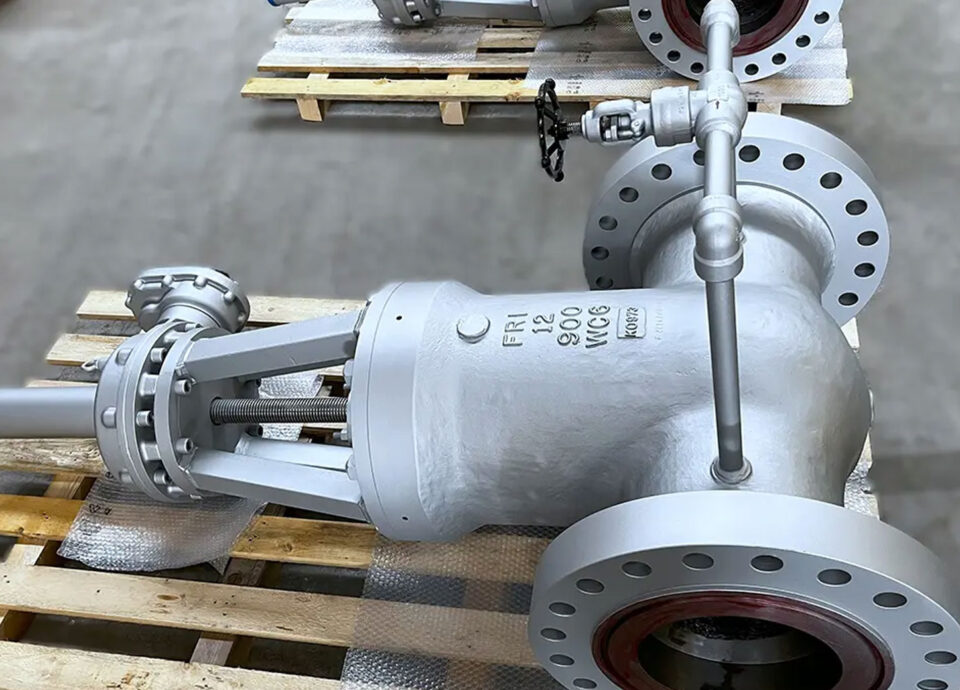A swivel flange is an innovative piping component specifically engineered to simplify and accelerate the crucial process of bolt hole alignment during flange connections. Unlike rigid, fixed flanges that demand precise rotational positioning of the entire pipe spool, a swivel flange boasts a clever two-piece design. It comprises an inner hub, which is permanently welded to the pipe end, and a separate, independently rotating outer ring that features the bolt holes. This ingenious structure allows installation crews to effortlessly spin the outer ring until its bolt holes align perfectly with those of the mating flange, even if the attached pipe itself isn’t in ideal rotational alignment.
This inherent rotational freedom is the key differentiator and primary advantage of a swivel flange. Picture the immense challenge of rotating a massive, multi-ton pipeline section in a tight module on an offshore platform or deep underwater. With a traditional fixed flange, such an operation would demand extensive rigging, specialized equipment, and potentially hours of meticulous adjustment. However, with a swivel flange, once the inner hub is welded, a technician can simply rotate the outer ring by hand, achieving precise bolt alignment in a matter of minutes. This not only dramatically cuts down installation time and labor but also significantly reduces the need for complex and costly pipe manipulation, leading to remarkable project efficiencies and reduced risk.
Swivel Flange Specifications, Dimensions, and Design Standards

A thorough understanding of the precise specifications, dimensions, and applicable design standards is absolutely fundamental when selecting any flange for industrial service. For swivel flanges, these parameters directly govern the component’s pressure containment capabilities, material compatibility with process fluids, and its overall structural integrity. Adherence to these established industry standards is paramount, ensuring both operational safety and seamless interchangeability within global piping systems.
ASME, ANSI, and API Standards for Swivel Flanges
Swivel flanges are manufactured under stringent international standards to guarantee consistent performance, safety, and compatibility across diverse industrial applications worldwide. The most prominent standards bodies influencing their design and production include the American Society of Mechanical Engineers (ASME), the American National Standards Institute (ANSI), and the American Petroleum Institute (API).
- ASME B16.5 and ASME B16.47: These are the bedrock standards for pipe flanges. ASME B16.5 specifically covers flanges up to NPS 24 (Nominal Pipe Size 24 inches), while ASME B16.47 addresses the larger diameter flanges, specifically ranging from NPS 26 through NPS 60. Swivel flanges designed to these specifications strictly adhere to precise requirements for pressure-temperature ratings, specific material grades, critical dimensions, manufacturing tolerances, and standardized testing procedures. For example, a Class 900 NPS 48 swivel flange intended for a high-pressure gas transmission line would rigorously follow ASME B16.47 Series A or B, which dictates its exact bolt circle diameter, the precise number of bolts, and specific facing dimensions to ensure proper mating.
- API 6A: This standard holds particular importance for swivel flanges utilized within the upstream oil and gas sector, especially for critical wellhead and Christmas tree equipment. API 6A imposes incredibly stringent requirements on design validation, material selection, manufacturing processes, welding procedures, and non-destructive examination (NDE) methods. For a swivel flange integrated into a subsea production manifold operating at pressures up to 15,000 psi (approximately 1034 bar), strict compliance with API 6A is vital. This ensures the component can reliably perform under such extreme pressures and corrosive downhole conditions, thereby maintaining critical well integrity and preventing costly environmental incidents.
Choosing a swivel flange that fully complies with these established industry standards is not merely a suggestion; it is an absolute necessity for ensuring system integrity, guaranteeing operational safety, and achieving long-term reliability in any demanding industrial application.
Choosing the Right Swivel Flange Size
Selecting the correctly sized swivel flange is a pivotal initial step that directly impacts the overall performance, safety, and longevity of a pipeline system. This crucial decision involves more than just visually matching pipe diameters; it requires a detailed understanding of the specific operational conditions and critical design parameters of the application.
| Feature | Quick Description |
|---|---|
| Nominal Pipe Size (NPS) | Standard pipe diameter range, e.g., NPS 4–60 for process to large pipelines. |
| Pressure Class (Rating) | Max system pressure at design temp; common: Class 150, 300, 600, up to 2500. |
| Flange Facing Type | Sealing face: RF, FF, or RTJ — selected by gasket type and sealing needs. |
| Material Grade | Material chosen for fluid, temp, strength: A105, LF2, F304, F316L, F11, etc. |
Always consult detailed engineering documentation, such as piping and instrumentation diagrams (P&IDs) and process flow diagrams (PFDs), to precisely determine the required swivel flange size and all associated specifications. Overlooking any of these critical parameters can lead to costly errors, ranging from minor operational inefficiencies to catastrophic system failures and severe safety hazards.
Types of Swivel Flanges for Different Pipeline Applications
While the overarching principle of a freely rotating bolt ring defines all swivel flanges, variations in their specific hub design make them uniquely suited for diverse pipeline applications. Understanding these different types is crucial for selecting the most appropriate and effective solution, ensuring both the structural integrity of the connection and maximum ease during installation in various industrial settings.
One of the most widely deployed types is the Welding Neck Swivel Flange. This design incorporates a substantial, tapered hub that is directly butt-welded to the pipe end. The welding neck configuration is highly prized for providing exceptional strength and superior structural integrity, making it an ideal choice for high-pressure, high-temperature, and critical service applications. This includes, for example, main oil and gas transmission pipelines, robust offshore risers, and process piping within demanding power generation or petrochemical plants where reliable, leak-proof connections capable of withstanding significant operational stresses are paramount. The gradual transition of the hub’s wall thickness to match the pipe wall minimizes stress concentration, a crucial factor for preventing fatigue failure in systems subjected to dynamic loading or persistent vibration.
Another significant variant is the Lap Joint Swivel Flange. Distinct from the welding neck type, this flange is not welded directly to the pipe. Instead, it’s used in conjunction with a “stub end”—a short, flanged piece of pipe that is butt-welded to the main pipeline. The lap joint swivel flange then slips freely over this stub end, remaining entirely rotatable. This design offers immense flexibility during assembly because the flange itself is not fixed by welding. It proves particularly advantageous in systems that necessitate frequent dismantling for inspection, cleaning, or routine maintenance, such as in food processing facilities, pharmaceutical plants, or utility lines, where quick and easy disassembly and reassembly are essential without compromising the integrity of the pipe’s primary weld. For instance, if a section of pipeline requires regular internal inspection via “pigging” (pipeline inspection gauging), a Lap Joint swivel flange connection can dramatically simplify the process, minimizing downtime and labor.
Swivel Flange vs Fixed Flange: Key Differences Explained
The strategic decision between deploying a swivel flange and a conventional fixed flange fundamentally boils down to balancing the initial component cost against the profound efficiencies gained during installation and the operational flexibility offered. While both components are engineered to fulfill the essential role of creating secure pipe connections, their underlying design philosophies lead to markedly different installation experiences, particularly in challenging and costly industrial environments.
The most critical distinction undeniably lies in their installation flexibility and tolerance for precise alignment. A fixed flange, such such as a standard Welding Neck or Slip-On, maintains its bolt holes in a rigid, predetermined position. This rigidity demands near-perfect rotational alignment of the entire pipeline section during the installation phase. Even a slight angular deviation of just a few degrees can render the bolting process exceedingly difficult, requiring substantial force, specialized heavy rigging, and often consuming many precious hours of valuable installation time. This frequently translates into significant project delays, escalating labor costs, and potential for strained connections, especially for large, heavy pipe spools. In stark contrast, the swivel flange is ingeniously designed to completely mitigate this challenge. Its inner hub is welded to the pipe, but crucially, its outer bolting ring is engineered to rotate freely around this hub. This ingenious feature allows installation crews to effortlessly spin the outer ring until its bolt holes align perfectly with the mating flange, irrespective of any minor rotational discrepancies in the overall pipe run. This dramatically simplifies and accelerates the bolt-up process.
Consider, for example, the installation of a 60-inch diameter subsea pipeline segment in deep water, where every minute of vessel time can cost upwards of $50,000. If relying on fixed flanges, a rotational misalignment of even 2-3 degrees could necessitate hours of re-rigging, complex underwater maneuvers by ROVs, and brute force to bring the pipe into perfect alignment. With a swivel flange, an ROV or diver could typically achieve precise bolt hole alignment in minutes by simply rotating the outer ring, leading to a demonstrable reduction in critical path installation time—often cited by subsea engineers as saving 30-50% of the bolt-up time on challenging deepwater connections. This efficiency gain isn’t merely about speed; it also significantly minimizes the risk of introducing detrimental residual stresses into the piping system, which can often occur when fixed flanges are forcibly aligned. Such forced alignments can compromise the long-term integrity and fatigue life of the connection, leading to premature leaks or failures.
Top 5 Benefits of Using Swivel Flanges Offshore and Subsea

Offshore oil and gas fields, alongside deepwater subsea installations, represent some of the most logistically complex, technically demanding, and exorbitantly costly environments for pipeline construction and maintenance. In these challenging settings, the unique design and operational advantages of swivel flanges translate directly into profound gains in efficiency, enhanced safety, and substantial project cost optimization.
Here are the top five compelling benefits that make swivel flanges indispensable in these critical applications:
- Drastically Reduced Installation Time & Vessel Expenses: This is perhaps the most significant economic advantage. In offshore and subsea operations, every hour of specialized vessel time (which can easily exceed $100,000 per day for a deepwater construction vessel) and every minute of diver or ROV (Remotely Operated Vehicle) work is incredibly expensive. Swivel flanges enable rapid, hassle-free bolt hole alignment without requiring the rotation of massive, heavy pipe sections or complex modules. This capability dramatically cuts down on critical path installation time, with major subsea projects reporting reductions of up to 45% in bolt-up durations for large connectors. This directly translates into multi-million dollar savings on overall project budgets.
- Enhanced Safety for Personnel & Equipment: By eliminating the need for awkward, forceful manipulations, or complex rigging to align misaligned bolt holes, swivel flanges significantly reduce the risk of accidents and injuries to installation crews, especially divers operating in challenging subsea conditions. They also minimize the potential for damaging highly valuable equipment due to stresses induced by misalignment. A smoother, more controlled alignment process leads to a safer work environment and fewer operational incidents.
- Superior Flexibility in Highly Challenging Conditions: Subsea currents, limited visibility, unpredictable seabed topography, and the inherent difficulty of precisely positioning very large pipe sections make traditional fixed flange alignment a logistical nightmare. The rotational freedom of a swivel flange provides crucial adaptability, allowing installers to achieve a perfect bolt-up even when ideal pipe positioning is unattainable. This flexibility reduces the need for costly re-work, repeated lifting operations, or difficult, time-consuming adjustments.
- Minimization of Harmful Residual Stresses on Piping Systems: When fixed flanges are forced into alignment, it invariably introduces significant and detrimental residual stresses within the pipe material and its welded connections. These induced stresses can severely compromise the pipeline’s fatigue life, increase susceptibility to stress corrosion cracking, and ultimately lead to premature leaks or catastrophic failures over its operational lifespan. Swivel flanges facilitate a stress-free bolt-up, preserving the designed integrity of the pipeline system and substantially extending its operational life, a critical factor for long-term subsea infrastructure reliability and performance.
- Optimized Overall Project Cost & Risk Mitigation: While a swivel flange might present a slightly higher unit material cost compared to a traditional fixed flange of equivalent specifications, the substantial savings generated from reduced vessel day rates, lower diver/ROV hours, minimized project delays, and decreased risk of costly rework far outweigh this initial component investment. For a typical deepwater oil and gas project, these cumulative efficiency gains and risk reductions can translate into tens of millions of dollars in net project savings, firmly establishing swivel flanges as a financially prudent and technically superior choice for such demanding applications.
Industry Insight: Leading subsea engineering firms and EPC (Engineering, Procurement, and Construction) contractors routinely specify swivel flanges as the preferred connection method for critical tie-ins due to their proven ability to mitigate significant installation risks and optimize demanding project schedules.
Common Swivel Flange Installation Mistakes to Avoid
Even with the inherent advantages that swivel flanges bring to the table, improper installation practices can unfortunately negate their benefits entirely, leading to serious operational issues ranging from minor, persistent leaks to catastrophic system failures. Therefore, diligently avoiding specific common mistakes is absolutely critical for ensuring a secure, leak-free, and long-lasting connection.
One of the most frequently encountered and detrimental errors is inadequate surface preparation of the pipe end before welding the inner hub of the swivel flange. Any lingering contaminants, such as rust, mill scale, grease, or improper beveling of the pipe edge, can severely compromise the quality of the weld joint. A weak, porous, or improperly fused weld, while seemingly minor initially, can become a critical point of failure under operational pressure and cyclic loading, potentially leading to costly and hazardous leaks. Always ensure that both the pipe end and the flange hub surfaces are meticulously cleaned, deburred, and prepared precisely according to the specified welding procedure specification (WPS) and industry best practices.
Another significant pitfall is failing to adhere strictly to the correct bolt tightening sequence and specified torque values. Even though the swivel flange simplifies bolt hole alignment, the bolts themselves must be tightened uniformly and systematically. An uneven tightening pattern (e.g., neglecting to follow a proper crisscross sequence) or applying incorrect torque can lead to uneven compression of the gasket, resulting in a compromised seal and eventual leakage. This critical step, often overlooked in the rush of installation, is just as vital as ensuring a VALVEHU valve is correctly seated and torqued for optimal performance. Furthermore, neglecting to verify the compatibility and pristine condition of the gasket itself is a common and often very costly oversight. The gasket material must be appropriate for the process fluid’s chemical properties, the precise operating temperature range, and the maximum pressure conditions. Using a damaged, incorrect material, or an expired gasket will almost certainly lead to a failed seal, regardless of how perfectly the flange bolt holes are aligned. For instance, using a standard non-asbestos gasket in a high-temperature (over 200°C) steam line designed for a spirally wound graphite gasket will result in rapid gasket degradation and immediate leakage. Always cross-reference the gasket specifications against the system’s operational parameters to prevent premature failure and ensure optimal sealing performance.
Where to Buy Swivel Flanges and How Much Do They Cost?
Sourcing high-quality swivel flanges is a vital step for guaranteeing the long-term integrity, operational reliability, and safety of any industrial piping system, particularly those deployed in harsh, critical, or remote environments. Their cost can fluctuate considerably based on several key factors, including the flange’s nominal pipe size (NPS), its specific pressure rating, the material of construction, and the chosen manufacturer or supplier.
For procurement, the primary and most reliable channels are specialized industrial valve and piping component suppliers and, in many cases, direct manufacturers themselves. Companies that focus on providing robust fittings and flow control solutions for the oil and gas, petrochemical, marine, and power generation industries typically maintain extensive inventories of various swivel flanges. It is highly recommended to partner with manufacturers or distributors who possess a strong reputation for adhering to rigorous international standards such as ASME and API, as this guarantees product quality, traceability, and certified compliance. For example, VALVEHU, a leading valve manufacturer and supplier in China, is globally recognized for its commitment to engineering excellence and offers a comprehensive range of flanges, including various types of swivel flanges meticulously tailored for diverse industrial needs. Engaging directly with reputable manufacturers like VALVEHU can often provide more competitive pricing, particularly for bulk orders or long-term supply agreements, owing to their integrated production capabilities and direct sales channels. When requesting a quotation, be prepared to furnish precise specifications: the Nominal Pipe Size (NPS), the required pressure class (e.g., Class 600, Class 1500), the specific material grade (e.g., ASTM A105 for carbon steel, ASTM A182 F316L for stainless steel), and the desired flange facing type (e.g., Ring Type Joint (RTJ) for high-pressure sealing).
The cost of swivel flanges can vary widely across the market. A smaller, lower-pressure carbon steel swivel flange (e.g., an 8-inch, Class 300) might range from approximately $550 to $1,300 USD. In sharp contrast, a large-diameter, high-pressure, or exotic alloy swivel flange (e.g., a 48-inch, Class 900 made from Super Duplex stainless steel for critical subsea applications) could easily command anywhere from $12,000 to over $40,000 USD, or even significantly more for highly customized designs requiring specialized metallurgy or stringent testing. These figures are general estimates and can fluctuate based on current raw material costs, global market demand, and supplier-specific pricing strategies. While the initial purchase price is undoubtedly an important financial consideration, always prioritize component quality, robust certification, and the manufacturer’s established reputation. Opting for a reliable, well-engineered swivel flange can prevent far costlier operational failures, extensive downtime, and severe safety incidents in the long run, proving its true value far beyond the initial price tag.
FAQ
Q1: What is the main advantage of a swivel flange for offshore oil and gas projects? The primary advantage is drastically reducing installation time and complexity by enabling effortless bolt hole alignment, which translates into significant savings on expensive vessel day rates and diver/ROV operational costs in challenging subsea environments.
Q2: How do swivel flanges contribute to system integrity? By allowing for flexible bolt hole alignment, swivel flanges eliminate the need to force misaligned pipes into position. This prevents the introduction of harmful residual stresses that could otherwise compromise the long-term fatigue life and integrity of the piping system.
Q3: Are there specific standards that govern the manufacturing of very large diameter swivel flanges? Yes, ASME B16.47 specifically addresses large diameter steel flanges, covering sizes from NPS 26 through NPS 60, and provides precise dimensions, material requirements, and testing criteria for these larger swivel flanges.
Q4: Can a swivel flange be used for highly corrosive process fluids? Absolutely. Swivel flanges are manufactured from a wide array of materials, including various grades of stainless steels (e.g., ASTM A182 F316L, Duplex F51) and specialized corrosion-resistant alloys, specifically chosen to handle a broad spectrum of highly corrosive fluids and extreme operating temperatures. The correct material selection is paramount for such applications.
Q5: What’s the typical pressure capability range for standard swivel flanges? Standard swivel flanges are designed to meet ASME pressure classes ranging from Class 150 (suitable for lower pressure applications, approximately 285 psi at ambient temperatures) up to Class 2500 (engineered for very high-pressure service, capable of handling over 6,000 psi), with their specific pressure ratings dependent on the material grade and operating temperature.
Resources
- ASME B16.5, Pipe Flanges and Flanged Fittings: NPS 1/2 Through NPS 24 Metric/Inch Standard, The American Society of Mechanical Engineers. https://www.asme.org/codes-standards/products/standards/b165-pipe-flanges-flanged-fittings-nps-1-2-nps-24
- ASME B16.47, Large Diameter Steel Flanges: NPS 26 Through NPS 60 Metric/Inch Standard, The American Society of Mechanical Engineers. https://www.asme.org/codes-standards/products/standards/b1647-large-diameter-steel-flanges-nps-26-nps-60
- API 6A, Specification for Wellhead and Christmas Tree Equipment, American Petroleum Institute. https://www.api.org/products-and-services/standards/important-standards/api-6a




